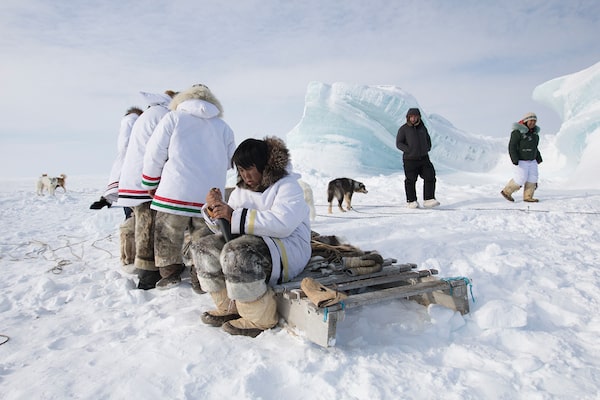
Apayata Kotierk as Noah Piugattuk in One Day in the Life of Noah Piugattuk.Isuma Distribution International
As the critics, curators and featured artists gather next week for media previews at the Venice Biennale Arte, the star of the Canadian pavilion will be more than 5,000 kilometres away. Filmmaker Zacharias Kunuk, whose Isuma collective is representing Canada at the 2019 edition of the prestigious Italian art exhibition, will be out on the land in Nunavut’s North Baffin region, north of the Arctic Circle. Technology willing, he will appear in Venice via satellite: Isuma’s Biennale programming includes Silakut: Live From the Floe Edge, a series of live interviews with Inuit about mining in the area.
There is much that is groundbreaking and little that is conventional about Isuma’s forthcoming appearance at the Biennale. Isuma is a film and video collective lead by Kunuk and his producing and writing partner, Montreal filmmaker Norman Cohn, who will be on the ground in Venice. There, they are unveiling a two-hour feature film at an international event that has seen lots of video art in its time, but is the more likely venue for site-specific material installations than narrative film.
Also, the Canadian pavilion, a shell-shaped modernist structure of wood, brick and glass, had become increasingly decrepit until a recent $3-million renovation: Isuma’s members will be the first artists to program the renewed space since it reopened at the architecture Biennale last year.
But the most notable aspect of this debut is simply that the group includes the first Inuit artists ever featured in the Canadian pavilion in six decades of programming.
“When we found out Isuma was representing Canada, our whole office was cheering; it’s a first,” recalled Alysa Procida, executive director of the Inuit Art Foundation. She added: “It’s a bold move to present a feature-length film at the Biennale, but Isuma is doing what it wants on its own terms. It’s important they are taking their own way and not doing what you might consider usual for a Biennale.”

The scripted feature is about an Inuit elder who resists moving his family into a government settlement in 1961.Levy Uttak/Isuma Distribution International
The main part of the project is One Day in the Life of Noah Piugattuk, a scripted feature in Inuktitut and English about an Inuit elder who resists moving his family into a government settlement in 1961. The film, written by Cohn, directed by Kunuk and shot on location in the region, is based on the story of the real Piugattuk. He was the elder of the last nomadic family forced by RCMP agents to give up a seasonal hunting camp and settle permanently in Igloolik, an island community between Baffin Island and the mainland that is also Kunuk’s hometown. Meanwhile, Isuma will be inviting viewers to browse their archive of 7,000 Indigenous videos created since 1985 as Isuma Online launches on iTunes, and it will be webcasting more of the Silakut program from Igloolik from time to time.
For Canadians, the issues surrounding indigeneity are top of mind, and Isuma’s work is widely recognized: In 2015, Canadian critics and film scholars named Atanarjuat: The Fast Runner, Kunuk’s mythic 2001 feature, the top Canadian film of all time. Atanarjuat also won the Camera d’or prize at the Cannes Film Festival in 2001, but Isuma remains much less recognized in Europe, where the notion of Indigenous-settler reconciliation is unfamiliar.
“I’m interested to see how it plays to a European audience,” Procida said. “Considering the work deals with colonialism, it will be differently received there.”
So how will Isuma fare at the exhibition sometimes known as the Olympics of art, a contest where the elbow-bruising first week ends with a prize for the best national pavilion?
“We are not making art for competition or crowds,” comments Vancouver art dealer Catriona Jeffries, who represents Canada’s 2017 Biennale artist, Geoffrey Farmer. That year, he took down the walls of the aging pavilion and filled it with gushing fountains, but Jeffries points out that previous Canadian showing, including Rebecca Belmore and Mark Lewis, have shown video and film at the Biennale. She sees Isuma’s team participation, from Igloolik to Venice, as particularly important. “A collaboration of artists looking at indigeneity, it’s prescient. … Geoffrey Farmer’s incredibly ambitious project took the building back to its bones. Now the building has refound itself.”
It does seem fitting that the work of Indigenous artists will christen the new pavilion: With reconciliation and a renovation, Canada’s 2019 Biennale marks a reset all round.
 Kate Taylor
Kate Taylor